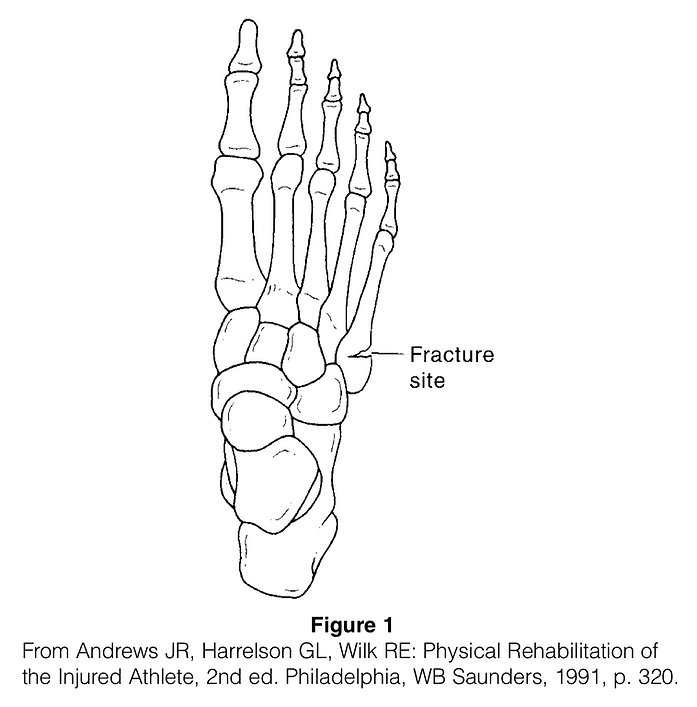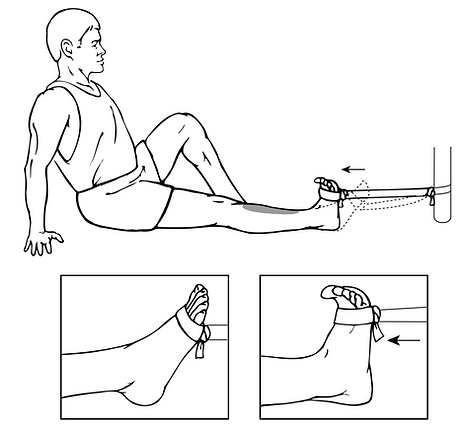Metatarsal Fracture (Including Jones and Dancer’s Fractures)
■ ■ ■ Description
Metatarsal fracture is a broken bone (fracture) in the middle of the foot. The mid-foot bones are of key importance in maintaining the arch of the foot. Three particular patterns are (1) stress fractures (not discussed here), (2) Jones fractures, and (3) dancer’s fractures. These last two fractures involve the upper part of the fifth metatarsal (outer part of the foot).Dancer’s fracture is an avulsion-type fracture in which a tendon pulls off some of the bone from the metatarsal near the joint with the mid-foot; these fractures heal well. Jones fracture, on the other hand, involves the shaft of the fifth metatarsal and has a propensity to not heal.
■ ■ ■ Common Signs and Symptoms
-
Sharp pain, especially with standing or walking
-
Tenderness, swelling, and later bruising of the foot
-
Numbness or paralysis from swelling in the foot, causing pressure on the blood vessels or nerves (uncommon)
■ ■ ■ Causes
-
Direct blow, twisting injury to the foot or ankle, or landing wrong on the foot and ankle
■ ■ ■ Risk Increases With
-
Participation in contact sports, sports that require jumping and landing (basketball, volleyball), or sports in which cleats are worn on shoes and sliding occurs
-
Previous foot or ankle sprains or dislocations
-
Repeated injury to any joint in the foot
-
Poor physical conditioning (strength and flexibility)
■ ■ ■ Preventive Measures
-
Appropriately warm up and stretch before practice or competition.
-
Maintain appropriate conditioning:
-
Cardiovascular fitness
-
Foot and ankle strength
-
Flexibility and endurance
-
-
For participation in jumping (basketball, volleyball) or contact sports, protect vulnerable joints with supportive devices, such as wrapped elastic bandages, tape, braces, or high-top athletic shoes.
-
Wear proper protective equipment and ensure correct fit.
■ ■ ■ Expected Outcome
With appropriate treatment and normal alignment of the bones, healing can be expected. The only exception to this is a higher risk of not healing (nonunion) with Jones fractures. Occasionally, surgery is necessary for healing of Jones fractures.
■ ■ ■ Possible Complications
-
Nonunion (fracture does not heal, particularly Jones fractures) or malunion (heals in a bad position)
-
Chronic pain, stiffness, or swelling of the foot
-
Excessive bleeding in the foot or at the dislocation site, causing pressure and injury to nerves and blood vessels (rare)
-
Unstable or arthritic joint following repeated injury or delayed treatment
■ ■ ■ General Treatment Considerations
If the bones are in appropriate alignment (position), the initial treatment consists of ice and elevation of the injured foot and ankle at or above heart level to reduce swelling. Crutches and medications help to relieve pain. Immobilization by splinting, bandaging, casting, or bracing for 6 or more weeks is usually recommended to protect the bones while they heal. Walking on the foot with a cast, brace, or wood-bottomed shoe may be recommended, especially if only one metatarsal is involved, the alignment is normal, and the fracture is not a Jones type. If the fracture is a Jones type, keeping strictly off your injured foot until the bone heals is mandatory. Severe fractures, fractures that are displaced (not in appropriate alignment), Jones fractures, and multiple metatarsal fractures may require surgery restore and maintain the joint to its normal position. After immobilization (with or without surgery), stretching and strengthening of the injured and weakened joint and surrounding muscles (due to immobilization and the injury) are necessary. These may be done with or without the assistance of a physical therapist or athletic trainer. Also, a stiff-soled shoe and arch support (orthotic) may be required when initially returning to sports.
■ ■ ■ Medication
-
Nonsteroidal anti-inflammatory medications, such as aspirin and ibuprofen (do not take within 7 days before surgery), or other minor pain relievers, such as acetaminophen, are often recommended. Take these as directed by your physician. Contact your physician immediately if any bleeding, stomach upset, or signs of an allergic reaction occur.
-
Strong pain relievers may be prescribed as necessary. Use only as directed and only as much as you need.
■ ■ ■ Cold Therapy
-
Cold is used to relieve pain and reduce inflammation. Cold should be applied for 10 to 15 minutes every 2 to 3 hours for inflammation and pain. Use ice packs or an ice massage.
■ ■ ■ Notify Our Office If
-
Pain, tenderness, or swelling worsens despite treatment
-
You experience pain, numbness, or coldness in the foot
-
Blue, gray, or dusky color appears in the toenails
-
Any of the following occur after surgery: fever, increased pain, swelling, redness, drainage, or bleeding in the surgical area
-
New, unexplained symptoms develop (drugs used in treatment may produce side effects)

➢RANGE OF MOTION AND STRETCHING EXERCISES • Metatarsal Fracture (Including Jones and Dancer’s Fractures)
These are some of the initial exercises you may start your rehabilitation program with after immobilization or surgery until you see your physician, physical therapist, or athletic trainer again or until your symptoms are resolved. Please remember:
-
Flexible tissue is more tolerant of the stresses placed on it during activities.
-
Each stretch should be held for 20 to 30 seconds.
-
A gentle stretching sensation should be felt.

STRETCH • Gastrocsoleus
-
Stand one arm length from the wall as shown. Place calf muscle to be stretched behind you as shown.
-
Turn the toes in and heel out of the leg to be stretched.
-
Lean toward wall leading with your waist, allowing your arms to bend. Keep your heel on the floor.
-
First do this exercise with the knee straight, then bend the knee slightly. Keep your heel on the floor at all times.
-
Hold this position for seconds.
-
Repeat exercise times, times per day.
RANGE OF MOTION • Ankle Alphabet
-
Write all the capital letters of the alphabet with your foot and ankle. The motion should come from your foot and ankle, not your hip or knee.
-
Move the foot and ankle slowly, writing the letters as large as possible/comfortable for you.
-
Repeat exercise times, times per day.


RANGE OF MOTION • Active Dorsi/Plantar Flexion
-
Pull your toes and foot toward your body as far as possible, then point the foot and toes away from body as far as possible.
-
Perform this exercise with the knee straight and then with the knee bent.
-
Hold this position for seconds.
-
Repeat exercise times, times per day.
➢STRENGTHENING EXERCISES • Metatarsal Fracture (Including Jones and Dancer’s Fractures)
These are some of the initial exercises you may start your rehabilitation program with after immobilization or surgery until you see your physician, physical therapist, or athletic trainer again or until your symptoms are resolved. Please remember:
-
Strong muscles with good endurance tolerate stress better.
-
Do the exercises as initially prescribed by your physician, physical therapist, or athletic trainer. Progress slowly with each exercise, gradually increasing the number of repetitions and weight used under their guidance.
STRENGTH • Dorsiflexors
-
Attach one end of elastic band to fixed object or leg of table/desk. Loop the opposite end around your foot as shown.
-
Slowly pull the foot toward you. Hold this position for seconds. Slowly return to starting position.
-
Repeat exercise times, times per day.


STRENGTH • Plantarflexors
-
Stand with feet shoulder-width apart. Hold on to counter or chair if necessary for balance.
-
Rise up on your toes as far as you can. Hold this position for seconds.
-
Complete this exercise using only one leg if it is too easy using both legs.
-
Repeat exercise times, times per day.
STRENGTH • Plantarflexors
-
Loop elastic band around foot as shown. Pull the band toward you with your hands.
-
Push your toes away from you slowly. Hold this position for seconds. Slowly return to starting position.
-
Repeat exercise times, times per day.


STRENGTH • Towel Curls
-
Sit in a chair and place a towel on a noncarpeted floor. Place your foot/toes on towel as shown. (You may also stand to do this exercise rather than sit.)
-
Curl/pull towel toward you with your toes while keeping your heel on the floor. Move towel with toes only. Do not move your knee or ankle.
-
If this is too easy, place a light weight (book, hand weight, etc.) at the far end of the towel.
-
Repeat exercise times, times per day.
STRENGTH • Ankle Eversion
-
Attach one end of elastic band to fixed object or leg of table/desk. Loop the opposite end around your foot.
-
Turn your toes/foot outward as far as possible, attempting to pull your little toe up and outward. Hold this position for seconds.
-
Slowly return to starting position.
-
Repeat exercise times, times per day.


STRENGTH • Ankle Inversion
-
Attach one end of elastic band to fixed object or leg of table/desk. Loop the opposite end around your foot.
-
Turn your toes/foot inward as far as possible, attempting to push your little toe down and in. Hold this position for seconds.
-
Slowly return to starting position.
-
Repeat exercise times, times per day.
View as PDF